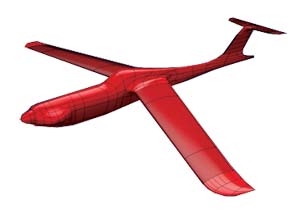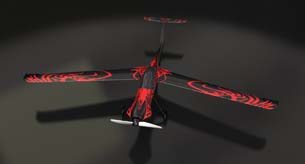Fast App: T-Splines Rethinks Surface Modeling for Manufacture
The ability to create large, unified surfaces allows greater freedom in designing complex organic shapes.
April 12, 2011
By Schuyler Greenawalt
 A Formula 1 Reno Racer. |
There’s a fundamental problem with non-uniform rational basis spline, or NURBS: While NURBS provides the underlying math for nearly all surface modeling for manufacture, the implementation of NURBS in surface modeling software has some inherent limitations. These limitations become especially apparent when creating complex blends among surfaces.
From the designer’s perspective, the limitations of NURBS are threefold:
1. The workflow itself can sometimes feel like one is stumbling around in the dark. Typically, to create a blend between two surfaces, you first trim those surfaces, and then create guide curves or surfaces to further define the blend. A blend surface is then created, using the existing geometry as input. Only after the designer has gone quite far down the path is the quality and shape of the blend surface apparent. If the resulting surface is not acceptable, the process must be iterated until an acceptable result is obtained. Essentially, the designer is being asked to define the surface blind, which creates a lot of needless work when trying to really refine a surface.
2. For blends to match up nicely at the edges, the surfaces themselves are often dense with isocurves. While the curve used to trim a surface for a blend may itself be quite simple, when that curve is projected onto the surface, the resulting edge is usually “heavy”—meaning it requires many points to be properly defined. The blend surface created with that edge as an input is likewise heavy. These blend surfaces almost always require small tweaks to get them to truly reflect the intent of the designer. However, because they are so dense with isocurves, point editing is daunting—if not impossible.
3. Because most NURBS surfaces are a collection of subsurfaces, changes to one can often necessitate changes to another, if not all of the other surfaces. This discourages the surface modeler from making changes to major portions of a model, simply because it can set off a chain reaction of changes in the rest of the model. This sometimes requires a total rebuild of the surface and creates additional cost.
 |
When designers run into these problems, they tend to think that the software platform they are running on is to blame—or that perhaps they have not fully mastered it. While this may be the case, more often they are actually bumping up against the inherent limitations of NURBS itself. Because NURBS provides the basis for surface modeling for manufacture, designers have just had to accept these limitations, as there has been no way of truly solving these design issues within the NURBS definition—until now.
In 2003, Dr. Thomas Sederberg of Brigham Young University invented T-Splines to solve these very problems. His son, Matt, and some of his students formed a company, T-Splines, Inc., to commercialize the technology. In 2007, they brought the power of T-Splines to the Rhino platform—and they recently added the ability to import and manipulate T-Splines surfaces into SolidWorks with a product called tsElements for Solidworks.
In a nutshell, T-Splines allows designers to add control to their surfaces in areas where they need it, but also terminate that control, so that the rest of the surface does not become needlessly heavy with isocurves—and therefore difficult to edit. This seemingly simple evolution of the NURBS architecture directly solves the problems outlined above, and allows a totally new and more intuitive workflow for surface modelers.
For the designer, the truly revolutionary aspect of T-Splines is that it allows the creation of large, complex surfaces, which are one single, unified element. This means that changes to one part of the model are seamlessly integrated into the surrounding geometry. The designer is free to change any portion of the model at any time, knowing that the surface will remain smooth and continuous.
Because areas of detail can be terminated, those complex blends that were so difficult to achieve in NURBS modeling packages are now just a handful of points, which can be pushed and pulled into the designer’s intended shape.
Best of all, T-Splines surfaces are 100% forward and backward compatible with NURBS surfaces, so a T-Spline surface is manufacturable.
From Input Geometry to Topology
For the designer accustomed to working in a traditional NURBS environment, the transition to T-Splines can seem a bit daunting at first. Whereas NURBS surfaces are typically defined by lofts and sweeps—and are highly dependent on the geometry fed into these functions—T-Splines surfaces often start with “primitives,” such as boxes, spheres and planes. These primitives are then pushed, pulled and modified into the desired shape.
Like NURBS, T-Splines surfaces employ a piecewise rectangular topology, so it becomes helpful for the designer to envision surfaces as a collection of rectangles.
|
Designing Aircraft with T-Splines for Rhino Aircraft design poses unusual challenges for surface modelers, because the wings and tails need to be very accurate representations of airfoils, but the rest of the surfaces—fuselages and other secondary structures—need to be very smooth and fair. The blends between the two can be particularly difficult, because they often end up too heavy to point edit. I was wasting a lot of time in the conceptual phase of the design, simply wrestling with making nice fillets between the wing and the fuselage. I found the quality of the blend was so dependent on the curves used to trim the fuselage that I had to undo and redo these trims over and over to get it just right. It was tedious, not always predictable, and definitely not fun. Once I realized that I could create the entire model as one unified T-Spline surface, however, I found that it transformed the quality of my model. It also created a totally different workflow, which saved time. I could now quickly and easily change any aspect of the model—be it the wingspan, dihedral, wing chord or fuselage width—and through it all, my model remained one unified surface. This meant I didn’t have to go back and redefine every surface that touched that changed element. It also meant that I could try out different ideas in a fraction of the time it would take me if I were just using standard NURBS commands. Furthermore, the quality of the blends between those surfaces is far better than I was able to achieve using NURBS, because they are part and parcel of the model. For example, those wing-to-fuselage blends that were so difficult in NURBS are now a joy to work with. The T-points allow me to “thin out” my topology from my wing, which demands a high degree of accuracy. Using 32 control points on both the top and bottom wing surface, I was able to keep my wing surface to within 0.002 in. of the airfoil shape. However, the blend between my wing and fuselage is formed by just a handful of points—12 on each side—and I have found I can push and pull on those points to get exactly the shape I want. With T-Splines I get the accuracy where I need it, and the nice smooth and fair surfaces everywhere else. It is, in a word, brilliant. While making an original T-Splines model is faster for me than doing the whole thing in NURBS, it’s hard to quantify this time savings. Where T-Splines clearly shines is in iterating. Once I have a T-Splines aircraft model created, it is far easier to make a new version of an aircraft from this master model. In fact, my experience has been that it takes 75% less time with T-Splines than with NURBS. |
More Info:
T-Splines, Inc.
School Street Design Co.
Schuyler Greenawalt owns School Street Design Co., Santa Cruz, CA.
Subscribe to our FREE magazine, FREE email newsletters or both!
About the Author
DE’s editors contribute news and new product announcements to Digital Engineering.
Press releases may be sent to them via [email protected].






